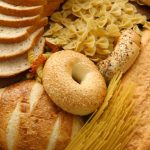The Gluten Face-Lift
Bread has been around for centuries! Why’s it suddenly bad?
First of all, full restoration isn’t possible until you put the right fuel in your tank. The gluten molecule is not problematic for anyone. However, compared to 100 years ago, the average American consumes extreme amounts of gluten today. The food manufacturing industry can’t get enough of gluten. It makes bread stretchy and soft, and keeps margarines, cheese spreads, dips, mustard, and canned meats smooth and predictable. The wheat we have today has a much higher concentration of gluten proteins than back in the day. The hard gluten truth is this: our bodies can’t process it all anymore. As a result, we end up reacting to it in strange and surprising new ways.
Tricky Gluten
While it’s easier to convince people that they have a problem with gluten if they immediately get sick from it, most people have delayed reactions to foods. As a result, their reactions seem unrelated to their digestion or food intake. As a result, they have a hard time identifying a problem and connecting it to their symptoms. Examples of symptoms include:
- Weight gain
- Sore muscles
- Achiness
- Headaches
- Hives
- Skin rashes
- Gastrointestinal upset
- Constipation
- Brain Fog
- Sugar cravings
- Depression
- Dairy intolerance
These kinds of reactions occur when we can’t break down certain types of proteins. At such times, our immune system recognizes a food particle as bad and attacks it, sending out inflammatory messengers to tag the food particle and attack and eliminate it from our bodies. This takes time, and it is why you may feel ill without knowing that the source of your illness is the food that you eat.
I want to go gluten-free. How do I start?
Step #1
Divorce wheat, barley, rye, spelt, kamut, Oats (unless certified gluten free) couscous, and bulghur.
Step #2
Learn the not-so-obvious sources of gluten: alcohol made from grains, canned meats, chewing gum, fruit drinks, horseradish sauce, ketchup, commercial salad dressings, commercially made canned or frozen soups, white pepper, malt, mustards, margarine, MSG, Glutamic Acid, and some skin-care products.
Rule #3
Get friendly with the vast world of gluten free foods. Figure out ingredients that will work for you and find recipes that are easy and convenient to make in a pinch.
Rule #4
Make it interesting and fun. Create a new grocery shopping routine. Invite friends along. Have gluten-free cooking parties where you all create and learn from each others’ easy, yummy gluten-free recipes.
Rule #5
Enjoy your healthier body. Taking gluten out can be a giant load off your system, improving your life in many ways. Sleep may come easier. Pain free days are sure to come. You may become less grumpy. You will definitely have more energy. Heck, you may even notice a difference in the glow of your skin and the sparkle in your eyes… which could mean more dates or an improved love life! You never know the miracles to come!
Call us with questions, or to make an appointment. Our office is your gluten-free resource for info and inspiration!





